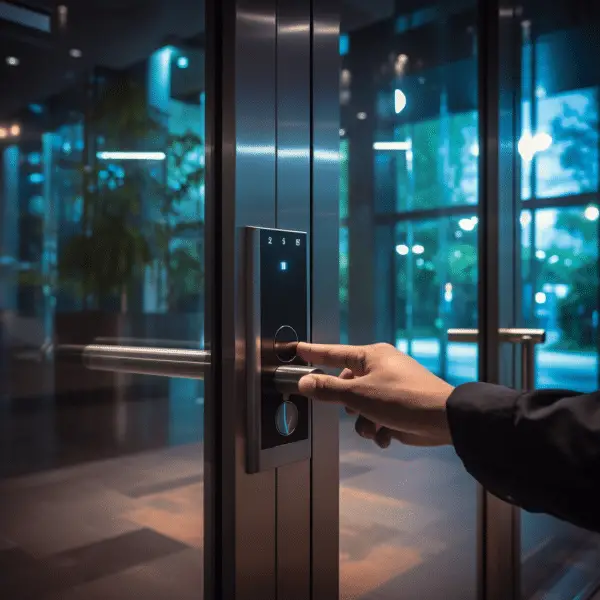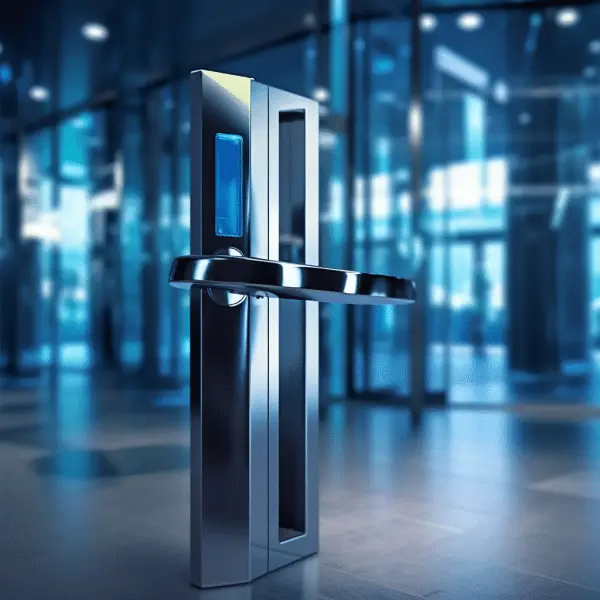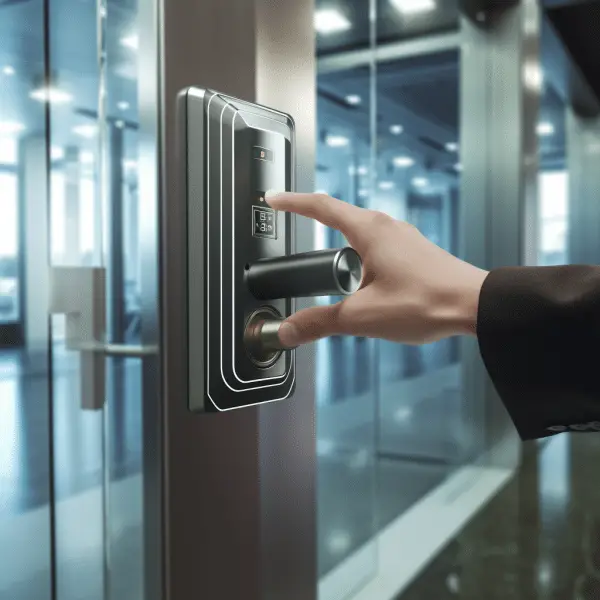Physical security plays a crucial role in access control systems, ensuring the protection of physical assets and maintaining the integrity of the overall security system. While digital security measures are essential, physical security measures are equally important in preventing unauthorized access and protecting against physical threats. By combining both digital and physical security, organizations can create a comprehensive access control system that safeguards their assets and ensures seamless operations.
Key Takeaways:
- Physical security is as important as digital security in access control systems.
- Physical security measures protect physical assets and prevent unauthorized access.
- A comprehensive access control system combines both digital and physical security measures.
- Physical security plays a crucial role in maintaining the integrity of the overall security system.
- By integrating physical and digital security, organizations can ensure business continuity and mitigate risks.
The Role of Physical Security in Access Control
Access control system effectiveness and integrity depend on physical security. In addition to digital security, physical security is crucial for preventing illegal access and physical hazards. By merging digital and physical security, organizations may establish a comprehensive access control solution to protect assets and streamline processes.
Physical security plays many roles in access control. A good access control system includes access control devices, video surveillance, perimeter protection, and physical barriers. These components prevent illegal access, identify and respond to physical threats, and safeguard important assets. Organizations may protect their buildings, personnel, and assets by adding physical security to access control systems.

Physical barriers
Access control devices, such as card readers and biometric scanners, form an essential component of physical security in access control. These devices ensure that only authorized individuals can enter restricted areas, minimizing the risk of unauthorized access. Video surveillance systems provide real-time monitoring and recording of activities, enhancing situational awareness and aiding in incident detection and response. Perimeter protection measures, such as fences, gates, and access control points, control access to the facility and act as a deterrent against intruders. Physical barriers, such as locks and alarms, further secure individual areas within the facility, adding an extra layer of protection.
| Components of Physical Security | Description |
|---|---|
| Access Control Devices | Includes card readers, biometric scanners, and other authentication methods to restrict access to authorized individuals. |
| Video Surveillance | Provides real-time monitoring and recording of activities for enhanced situational awareness and incident detection. |
| Perimeter Protection | Includes fences, gates, and access control points to control access to the facility and deter potential intruders. |
| Physical Barriers | Includes locks, alarms, and other physical deterrents to secure individual areas within the facility. |
In conclusion, physical security plays a vital role in access control systems by preventing unauthorized access, detecting and responding to physical threats, and safeguarding critical assets. By integrating access control devices, video surveillance systems, perimeter protection, and physical barriers, organizations can create a secure environment that mitigates the risk of unauthorized access. The combination of digital and physical security measures ensures a holistic approach to access control and enhances overall security.
Key Components of Physical Security in Access Control
In access control systems, physical security entails a combination of various components that work together to create a robust and comprehensive security system. These components include:
Access Control Devices
Access control devices, such as card readers and biometric scanners, play a crucial role in ensuring that only authorized individuals can enter restricted areas. These devices provide a secure method of authentication and help in controlling and monitoring access to specific locations within a facility.
Video Surveillance Systems
Video surveillance systems are essential for enhancing situational awareness and monitoring activities in real-time. These systems not only act as a deterrent to potential intruders but also provide valuable evidence in the event of security incidents. By capturing and recording video footage, organizations can enhance their security posture and enable efficient incident investigation.
Perimeter Protection
Perimeter protection measures, such as fences, gates, and access control points, are instrumental in controlling access to a facility. These physical barriers act as the first line of defense, preventing unauthorized entry and deterring potential threats. By securing the perimeter, organizations can maintain a controlled and secure environment for their operations.
Physical Barriers
Physical limits, like locks and alarms, are very important for keeping different parts of a building safe. By making it hard to get to certain rooms, boxes, or pieces of equipment, these barriers add an extra layer of security. By putting up physical barriers, businesses can make sure that only authorized staff can get to sensitive areas. This lowers the chance of someone getting in without permission or messing with the data.
By incorporating these key components into access control systems, organizations can establish a comprehensive physical security framework that addresses the specific security needs of their facilities. Each of these components plays a vital role in safeguarding assets, preventing unauthorized access, and mitigating physical threats.
Note: See the table below for a summary of the key components of physical security in access control.
| Component | Description |
|---|---|
| Access Control Devices | Devices such as card readers and biometric scanners that ensure authorized access to restricted areas. |
| Video Surveillance Systems | Systems that provide real-time monitoring and recording of activities for enhanced situational awareness. |
| Perimeter Protection | Measures like fences, gates, and access control points that control access to the facility. |
| Physical Barriers | Locks and alarms that secure individual areas within the facility. |
Benefits of Physical Security in Access Control
Physical security methods like access control, video monitoring, and physical barriers can protect expensive assets, equipment, and sensitive data against theft, damage, and unwanted access. This protects the company’s reputation and shareholder trust.
Incident detection and response are another feature of physical access control security. Video surveillance systems may detect and resolve security incidents in real time, reducing risk. Physical security also deters intruders, improving the organization’s security.
Furthermore, physical security in access control systems contributes to the overall efficiency and effectiveness of the organization. By implementing robust physical security measures, organizations can create a secure and protected environment, enabling seamless operations and business continuity. This not only promotes productivity but also ensures the safety and well-being of employees, visitors, and customers.
Table: Benefits of Physicals Security in Access Control
| Benefits | Description |
|---|---|
| Asset Protection | Prevents theft, damage, and unauthorized access to valuable assets, equipment, and sensitive information. |
| Incident Detection and Response | Real-time monitoring helps identify and respond to security incidents, minimizing their impact and preventing potential threats. |
| Deterrence | Acts as a deterrent, discouraging potential intruders from attempting unauthorized access. |
| Efficiency and Effectiveness | Creates a secure environment that enables seamless operations, promoting productivity and business continuity. |
In conclusion, physicals security in access control systems benefits enterprises. Physical security measures protect assets and detect and respond to incidents, improving the organization’s security, efficiency, and effectiveness. Organizations can develop a comprehensive access control system that protects assets, mitigates risks, and runs smoothly by prioritizing physicals security alongside digital security.
Integration of Physicals and Digital Security in Access Control
In today’s fast-changing security world, physical and digital security must be integrated for complete access management. Organizations may build a strong, layered security system that mitigates risks and protects assets by combining physical and digital security measures. This connection streamlines access control policy management, activity monitoring, and security incident response.
When physical and digital security are linked, card readers and biometric scanners cooperate with digital identity management systems to restrict access to restricted locations. Real-time video surveillance improves situational awareness and incident response. This holistic approach to access management lets firms create a comprehensive security plan, lowering risks and improving security.
Putting together physical and digital security can help businesses become better and lower their risks. Access control systems can make it easier to find people and be sure they are who they say they are by using cutting edge technologies like face recognition, AI, and cloud-based solutions. They can also help with security operations and knowing what’s going on around you. Because IoT and physical security can work together, security processes can be made easier and more connected.
Benefits of integrating physicals and digital security in access control:
- Enhanced security: The combination of physical and digital security measures provides a more robust and layered security system, minimizing vulnerabilities and enhancing protection against unauthorized access.
- Improved incident response: The integration allows for real-time monitoring, alerting, and quick response to security incidents, enabling organizations to address threats swiftly and effectively.
- Efficient management: The seamless integration of physicals and digital security enables efficient management of access control policies, simplifying administration and reducing administrative overhead.
- Comprehensive risk mitigation: The holistic approach to access control through the integration of physical and digital security measures helps organizations mitigate risks across both physicals and digital domains, ensuring comprehensive security.
Organizations may establish a comprehensive security system that addresses modern threats and problems by integrating physicals and digital security with access control. This integration improves security and helps enterprises react to the changing security landscape.
| Physical Security | Digital Security |
|---|---|
| Access control devices | Identity management systems |
| Video surveillance systems | Intrusion detection systems |
| Perimeter protection | Network security |
| Physical barriers | Data encryption |
Emerging Trends in Physical Security for Access Control
With the continuous advancement of technology, the field of physical security in access control is experiencing exciting new trends. These emerging trends are shaping the future of access control systems, enhancing their effectiveness and incorporating advanced technologies. Here are some of the key trends that are revolutionizing physical security:
Advanced Technologies
One of the prominent emerging trends in physical security is the integration of advanced technologies into access control systems. Facial recognition technology, for example, allows for more accurate identification and authentication of individuals, enhancing the overall security of access control systems. Artificial intelligence is also being utilized to analyze data and detect anomalies, improving threat detection capabilities. Cloud-based solutions are becoming increasingly popular, enabling centralized management of access control systems and providing flexibility and scalability.
IoT Integration
The Internet of Things (IoT) is changing the way that access control systems protect real space. When companies combine physical security systems with IoT technologies, they can get better control, connectivity, and automation. Internet of Things (IoT)-enabled locks, for example, can be managed and watched from afar, making things easier and safer. When IoT devices are connected to access control systems, data can be collected, analyzed, and responded to in real time. This makes it easier to know what’s going on and take preventative security steps.
Enhanced Data Analytics
Data analytics is a very important part of how physical security and access control are changing. Advanced analytics tools are being used to look at huge amounts of data that come from different types of physical security devices, like video surveillance cams and access control systems. These analytics help businesses find trends, spot outliers, and get useful information they can use to make security better. By using data analytics, businesses can find possible security risks ahead of time, make better use of their resources, and speed up the time it takes to respond to incidents.
| Emerging Trends in Physical Security for Access Control | Description |
|---|---|
| Advanced Technologies | Integration of facial recognition, artificial intelligence, and cloud-based solutions into access control systems for enhanced security and management. |
| IoT Integration | Integration of physical security devices with IoT technologies for increased connectivity, automation, and real-time data analysis. |
| Enhanced Data Analytics | Utilization of advanced analytics tools to analyze data from physical security devices, enabling proactive security measures and optimized response. |
These emerging trends in physical security for access control are transforming the way organizations approach security management. By embracing these trends, organizations can stay ahead of potential threats, enhance situational awareness, and ensure the safety and security of their facilities, employees, and assets.

Conclusion
Finally, physicals security in access control systems is crucial. Digital security is important, but physical security protects assets and prevents illegal access. By combining digital and physicals security, enterprises can establish a complete access control system to protect their premises.
An efficient access control system starts with physicals security. It includes entry control, video surveillance, perimeter protection, and physical obstacles. These components prevent illegal access, identify and respond to physical threats, and protect important assets.
There are many benefits to adding physicals security to access control systems. It prevents theft and damage, aids incident detection and response, and deters attackers. By integrating physical and digital security, organizations may improve security, reduce risks, and assure business continuity.
As physicals security evolves, sophisticated technologies and IoT integration improve access control systems. These developments improve identity, authentication, situational awareness, and security process centralization.
Organizations must prioritize physicals security in access control to preserve security. By combining digital and physicals security, organizations may establish a powerful access control system to protect their facilities, employees, and assets.
FAQ
What is the role of physical security in access control?
Physical security plays a crucial role in access control systems by preventing unauthorized access and protecting against physical threats.
What are the key components of physical security in access control?
The key components of physical security in access control include access control devices, video surveillance systems, perimeter protection, and physical barriers.
What are the benefits of incorporating physical security into access control systems?
Incorporating physical security into access control systems helps protect assets, detect and respond to incidents, and acts as a deterrent against intruders.
How does the integration of physical and digital security enhance access control systems?
Integrating physical and digital security allows for seamless management, efficient monitoring, and quick response to security incidents in access control systems.
What are the emerging trends in physical security for access control?
Some emerging trends include the use of advanced technologies such as facial recognition and artificial intelligence, as well as the integration of physical security with the Internet of Things (IoT).

